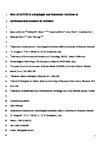Role of mTOR in autophagic and lysosomal reactions to environmental stressors in molluscs
| dc.contributor.author | Sforzini, S | |
| dc.contributor.author | Moore, MN | |
| dc.contributor.author | Oliveri, C | |
| dc.contributor.author | Volta, A | |
| dc.contributor.author | Jha, Awadhesh | |
| dc.contributor.author | Banni, M | |
| dc.contributor.author | Viarengo, A | |
| dc.date.accessioned | 2018-09-13T11:33:44Z | |
| dc.date.available | 2018-09-13T11:33:44Z | |
| dc.date.issued | 2018-02 | |
| dc.identifier.issn | 0166-445X | |
| dc.identifier.issn | 1879-1514 | |
| dc.identifier.other | C | |
| dc.identifier.uri | http://hdl.handle.net/10026.1/12353 | |
| dc.description | publisher: Elsevier articletitle: Role of mTOR in autophagic and lysosomal reactions to environmental stressors in molluscs journaltitle: Aquatic Toxicology articlelink: https://doi.org/10.1016/j.aquatox.2017.12.014 content_type: article copyright: © 2017 Elsevier B.V. All rights reserved. | |
| dc.description.abstract |
Lysosomal membrane stability (LMS) has been used in various organisms as a very sensitive biomarker of stress. However, despite the abundance of data about regulation of the autophagic process in mammals, in the invertebrates there is only limited mechanistic understanding. Marine mussels (Mytilus galloprovincialis Lam.) are bivalve molluscs, widely used as models in ecotoxicology and as environmental bioindicators of sea water quality. In order to elucidate this fundamental process, in the present study, mussels were exposed for 3 days to a "priority", ubiquitous environmental contaminant, benzo[a]pyrene (B[a]P) at different concentrations (i.e. 5, 50, 100 μg/L seawater). B[a]P accumulated in lysosomes of digestive tubule epithelial cells (digestive cells) and in enlarged lipid-rich lysosomes (autolysosomes) as detected by immunofluorescence and UV-fluorescence. B[a]P also activated the autophagic process with a marked decrease of LMS and concurrent increase in lysosomal/cytoplasmic volume ratio. Dephosphorylation of mTOR contributes to increased lysosomal membrane permeability and induced autophagy. B[a]P induced a decrease in phosphorylated (active form) mTOR. The probable role of mTOR in cell signalling and the regulation of the cellular responses to the contaminants has been also confirmed in a field study, where there was significant inactivation of mTOR in stressed animals. Statistical and network modelling supported the empirical investigations of autophagy and mTOR; and was used to integrate the mechanistic biomarker data with chemical analysis and DNA damage. | |
| dc.format.extent | 114-128 | |
| dc.format.medium | Print-Electronic | |
| dc.language | en | |
| dc.language.iso | en | |
| dc.publisher | Elsevier | |
| dc.subject | Mussel | |
| dc.subject | Autophagy | |
| dc.subject | B[alpha]P | |
| dc.subject | mTOR | |
| dc.subject | Network modelling | |
| dc.title | Role of mTOR in autophagic and lysosomal reactions to environmental stressors in molluscs | |
| dc.type | journal-article | |
| dc.type | Journal Article | |
| plymouth.author-url | https://www.webofscience.com/api/gateway?GWVersion=2&SrcApp=PARTNER_APP&SrcAuth=LinksAMR&KeyUT=WOS:000424723800014&DestLinkType=FullRecord&DestApp=ALL_WOS&UsrCustomerID=11bb513d99f797142bcfeffcc58ea008 | |
| plymouth.volume | 195 | |
| plymouth.publication-status | Published | |
| plymouth.journal | Aquatic Toxicology | |
| dc.identifier.doi | 10.1016/j.aquatox.2017.12.014 | |
| plymouth.organisational-group | /Plymouth | |
| plymouth.organisational-group | /Plymouth/Admin Group - REF | |
| plymouth.organisational-group | /Plymouth/Admin Group - REF/REF Admin Group - FoSE | |
| plymouth.organisational-group | /Plymouth/Faculty of Science and Engineering | |
| plymouth.organisational-group | /Plymouth/Faculty of Science and Engineering/School of Biological and Marine Sciences | |
| plymouth.organisational-group | /Plymouth/REF 2021 Researchers by UoA | |
| plymouth.organisational-group | /Plymouth/REF 2021 Researchers by UoA/UoA06 Agriculture, Veterinary and Food Science | |
| plymouth.organisational-group | /Plymouth/Research Groups | |
| plymouth.organisational-group | /Plymouth/Research Groups/Marine Institute | |
| plymouth.organisational-group | /Plymouth/Users by role | |
| plymouth.organisational-group | /Plymouth/Users by role/Academics | |
| plymouth.organisational-group | /Plymouth/Users by role/Researchers in ResearchFish submission | |
| dc.publisher.place | Netherlands | |
| dcterms.dateAccepted | 2017-12-27 | |
| dc.rights.embargodate | 2018-12-28 | |
| dc.identifier.eissn | 1879-1514 | |
| dc.rights.embargoperiod | Not known | |
| rioxxterms.versionofrecord | 10.1016/j.aquatox.2017.12.014 | |
| rioxxterms.licenseref.uri | http://www.rioxx.net/licenses/all-rights-reserved | |
| rioxxterms.licenseref.startdate | 2018-02 | |
| rioxxterms.type | Journal Article/Review | |
| plymouth.funder | Elucidating the potential interaction of manufactured nanoparticles with polycyclic aromatic hydrocarbons: An integrated toxicogenomics approach::NERC |


